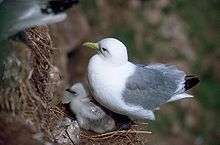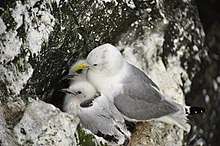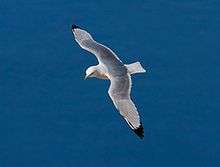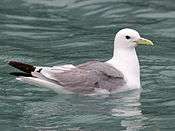Black-legged kittiwake
The black-legged kittiwake (Rissa tridactyla) is a seabird species in the gull family Laridae.
| Black-legged kittiwake | |
|---|---|
.jpg) | |
| Scientific classification | |
| Kingdom: | Animalia |
| Phylum: | Chordata |
| Class: | Aves |
| Order: | Charadriiformes |
| Family: | Laridae |
| Genus: | Rissa |
| Species: | R. tridactyla |
| Binomial name | |
| Rissa tridactyla | |
| Range of R. tridactyla Summer range Wintering range | |
| Synonyms | |
| |
This species was first described by Carl Linnaeus in his landmark 1758 10th edition of Systema Naturae as Larus tridactylus.[2] The English name is derived from its call, a shrill 'kittee-wa-aaake, kitte-wa-aaake'.[3] The genus name Rissa is from the Icelandic name rita for this bird, and the specific tridactyla is from Ancient Greek tridaktulos, "three-toed", from tri-, "three-" and daktulos, "toe".[4]
In North America, this species is known as the black-legged kittiwake to differentiate it from the red-legged kittiwake, but in Europe, where it is the only member of the genus, it is often known just as kittiwake.
Range and distribution
The black-legged kittiwake is a coastal bird of the arctic to subarctic regions of the world.[5] It can be found all across the northern coasts of the Atlantic, from Canada to Greenland as well as on the Pacific side from Alaska to the coast of Siberia.[6] Black-legged kittiwakes' wintering range extends further south from the St-Lawrence to the southern coast of New Jersey as well as in China, the Sargasso sea and of the coast of west Africa.[6][7] There are two subspecies of black-legged kittiwake. Rissa tridactyla tridactyla can be found on the Atlantic coast whereas Rissa tridactyla pollicaris is found on the Pacific coast.
Out of all the laridae, the kittiwakes are the most pelagic ones. Kittiwakes are almost exclusively found at sea with the exception of the breeding period, from May to September, where they can be found nesting on the sheerest sea cliffs. They are rarely found inland, though they have been reported on few instances as far as 20 km inland.[6] For the rest of the year, kittiwake spend most of their time on the wing out of sight from the coast.
Description
Adult plumage
The adult is 37–41 cm (15–16 in) in length with a wingspan of 91–105 cm (36–41 in) and a body mass of 305–525 g (10.8–18.5 oz).[8] It has a white head and body, grey back, grey wings tipped solid black, black legs and a yellow bill. Occasional individuals have pinky-grey to reddish legs, inviting confusion with red-legged kittiwake. The inside of their mouth is also a characteristic feature of the species due to its rich red colour. Such red pigmentation is due to carotenoids pigments and vitamin A which have to be acquired through their diet.[9] Studies show that integument coloration is associated with male's reproductive success.[9] Such hypothesis would explain the behavior of couples greeting each other by opening their mouth and flashing their bright mouth it to their partner while vocalizing.[10] As their Latin name suggests, they only possess three toes since their hind toe is either extremely reduced or completely absent.[7] The two subspecies being almost identical, R. tridactyla pollicaris is in general slightly larger than its counterpart R. tridactyle tridactyla. In winter, this species acquires a dark grey smudge behind the eye and a grey hind-neck collar. The bill also turns a dusky-olive color.[7]
Since kittiwakes winter at sea and rarely touch ground during this period, very little is known about their exact molting pattern.
Juvenile plumage
At fledging, the juveniles differ from the adults in having a black 'W' band across the length of the wings and whiter secondary and primary feathers behind the black 'W', a black hind-neck collar and a black terminal band on the tail.[5] They can also be identified due to their solid black bill.[5] This plumage is a hatch-year plumage and will only remain for their first year.[11] Kittiwakes obtain their mature plumage at 4 years old, but will gradually change their juvenile plumage over time until maturity is reached. A second-year juvenile resembles a hatch-year regarding the plumage, though the bill is no longer solid black but instead has a greenish color.[11] The black marking on the coverts and the tail is still visible. The black marking will only molt during their third year, where the black is no longer present on the coverts, but the grey smudge on the head remains.[11] A third-year bird will also exhibit a small zone of bright yellow/orange at the base of its mostly greenish bill. It is only at four years old that the bill will reach an overall colour of bright yellow and complete its mature plumage.[11]
The old fisherman's name of "tarrock" for juvenile kittiwakes is still occasionally used.
| Standard measurements[12][13] | |
|---|---|
| length | 410–460 mm (16–18 in) |
| weight | 400 g (14 oz) |
| wingspan | 910 mm (36 in) |
| wing | 295–322 mm (11.6–12.7 in) |
| tail | 124–136 mm (4.9–5.4 in) |
| culmen | 33–39 mm (1.3–1.5 in) |
| tarsus | 32–36 mm (1.3–1.4 in) |
Similar species
The red-legged kittiwake is the only other species in the Rissa genus and can be differentiated from its counterpart by its red legs, as the name suggests.[14] The head of the red-legged kittiwake is slightly smaller and bears a shorter bill.[14] The chicks of the Pacific black-legged kittiwake and red-legged kittiwake cannot be distinguished during their youngest downy phase.[14]
The juvenile black-legged kittiwake can be confused with the Bonaparte's gull juveniles although the kittiwakes' plumage has more black on the primaries and a different pattern going across the coverts.[10]
Breeding



It is a coastal breeding bird around the north Pacific and north Atlantic oceans, found most commonly in North America and Europe. Kittiwakes are colonial nesters that form monogamous pairs and exhibit biparental care, meaning that both take part in nest building, incubation and chick rearing. They tend to nest in large numbers on cliffs by the sea side. It breeds in large colonies on cliffs and is very noisy on the breeding ground. Cliff nesting for gulls occurs only in the Rissa species, and the kittiwake is capable of utilizing the very sheerest of vertical cliffs, as is evident in their nesting sites on Staple Island in the outer Farne Islands. There are few instances of kittiwakes nesting on man-made structure in Europe and Alaska. Kittiwake pairs both participate in building the nest in which the female will lay their eggs. The breeding season begins in mid-June and usually end in august.[15]
Nest formation
Building the nest in order to welcome their fragile eggs is a tedious task and requires time and energy. The parents begin with a layer of mud and grass in order to form a platform that will cushion and help to isolate the eggs from the cold ground.[16] A cup is then built around the platform in order to keep the eggs from rolling out of the nest.[16] Finally, the nest is lined with soft and dry material such as moss, grass or seaweed.[16] The nest is solidified by a continuous trampling of the materials by the pair.[15] Throughout this period, the male will do courtship feeding by feeding the female at their nest site.[17] The reasons for such behavior are not quite understood but many hypothesis have been brought up to explain the phenomenon. Hypothesis such as the "nutrition hypothesis" and the "copulation enhancement hypothesis" have shown evidence that this behavior evolved either through natural or sexual selection.[17][18]
Egg formation and incubation
Kittiwakes are single-brooded, meaning that the pair will only reproduce once per year. Egg formation within the female usually takes around 15 days and normal egg clutch size ranges from one to two sub-elliptical eggs, though three eggs clutches are not impossible.[15] The female will lay eggs on alternate days.[15] The eggs' color varies quite a bit, ranging from white, brownish to turquoise with dark brown speckles.[16] Once the eggs are laid, the parents will take turns and incubate their clutch for an average period of 27 days.[19] In case of egg loss, the female might relay another egg within 15 days after the loss.[16]
Chick-rearing
Chicks usually hatched through the larger end of the egg using their egg tooth.[16][20] The egg tooth usually disappear after seven days post-hatching.[20] The alpha and beta chicks tend to hatch 1.3 days apart.[16] Kittiwake are born semi-precocial. The downy young of kittiwakes are white, since they have no need of camouflage from predators, and do not wander from the nest like Larus gulls for obvious safety reasons. Regardless of predation, the chicks are most vulnerable within their first week due to their incapacity to properly thermoregulate during that period.[16][20] Kittiwake chicks also exhibit siblicide, meaning that the first-born chick may kill its sibling in order to avoid competition for food from their parents.[20] If siblicide is to occur, it will most likely occur within the first 10 days of life of the smaller chick, in most cases the last born.
The downy plumage of chicks start to be replaced by the juvenile plumage only five days after hatching and will continue to do so for about 30 days, until the juvenile plumage is complete. It is not long after the completion of their juvenile plumage that the chicks will have their first flight at 34–58 days old.[21] Chicks will come back to the nest for several weeks after hatching and will eventually follow the adults at sea where they spend the winter.[21] Kittiwakes reach sexual maturity at around 4–5 years old.[20]
Behavior
Feeding and diet
Kittiwakes are primarily pelagic piscivorous birds. Their main food source consists of fish, though it is not unlikely to find invertebrates such as copepods, polychete and squids in their diet, especially when fish is harder to find.[21] Due to their wide range, kittiwake diet is quite variable. In the Gulf of Alaska, their diet is usually composed of Pacific capelin, Pacific herring, Pacific sand land and much more. Kittiwakes of the coast of the United Kingdom, in Europe, rely mostly on sandeels.[22] In 2004, the kittiwake population in the Shetland islands, along with the murre (guillemot) and tern [16] population, completely failed to reproduce successfully due to a collapse in sandeel stock.[23] Like most gulls, kittiwake forage at the surface of the water where they tend to catch their prey while in flight or sitting on the water. Throughout winter, kittiwakes spend all of their time at sea where they forage. Unlike some gull species, they do not scavenge at landfills.[16][21]
The foraging style of the kittiwakes is often compared to the terns' foraging strategy due to their frequent hovering and their head diving quickly at the surface of the water.[7] Instances of kittiwakes following whales are also common since they benefit from the fish fragments expelled by these huge marine mammals.[7] Fishers and commercial fishing boats are also the frequent witnesses of big groups of kittiwakes, often mixed with other gull species and terns, hovering around their ship in order to benefit from the scraps rejected in their sewage water or thrown overboard.[6]
There are few studies focussing on their water needs, though they seem to prefer salt water to fresh water.[7][10] Captive kittiwakes are known to refuse fresh water but will willingly drink salt water.[10]
Vocalization
The kittiwake is named after its call that resembles a long "kit-ti-wake".[7] Apart from their typical call, kittiwakes have a wide array of vocalization. Their greeting call is used by the two members of a pair when meeting at the nest after an absence of one or both members. Before and during copulation, the female will often vocalize by making a series of short high pitched "squeak".[16] This call is also used by the female to beg for food from the male (courtship feeding). When predators are around, the kittiwake alarm call, an "oh oh oh oh" will be heard all across the colony.[16] Kittiwake will vocalize all day for various reasons and will only stop when the sun is down.
Flight
Kittiwake are known for their graceful flight. Unlike larger gulls, their flight is light with the wings beating in fast strokes.[10] When looking at them flying around the colony, kittiwakes often look as if they are playing in the wind with their agile flips and loops. Kittiwakes are highly gregarious and therefore are rarely seen flying alone far away from the colony.[10]
Relationship with humans
Kittiwakes are a frequent encounter of fisheries in northern regions. Their diet consisting almost exclusively of fish, fishermen tend to seek large aggregation of seabirds since they are often a sign of fish abundance.[10] On the other hand, kittiwake and other seabirds hang around fishing boats or platforms to collect scraps or any fish that might have been left out.[6] Due to the kittiwake pelagic lifestyle, they rarely interact with humans on the land, other than occasional sight near the ocean's coast.
In New England, the black-legged kittiwake is often called the "winter gull" since its arrival often signals to people that winter is coming.[10]
Conservation
Population trends
Since 1970s, its it believed that the global population of black-legged kittiwake has declined of about 40% in only three generations (one generation is in average 12.9 years), putting the species in a dangerous place for the future.[24] The global population is estimated at 14,600,000-15,700,000 individuals and is in constant decline. The individual distribution of kittiwakes across the world varies quite a bit, with Europe representing more than 50% of the world's kittiwake and North America representing only 20%. In their recent species assessment, the IUCN Red List pointed out that all but one populations of kittiwakes were in decline, with the exception of the small Canadian arctic population that seems to be increasing at a rate of 1% per year.[24] The last IUCN Red List report in 2017, the species was moved from "least concern" to a "vulnerable" status on a global scale.[24]
Threats
Fisheries
Since the kittiwakes are fish specialist and tend to rely on prey species, their reproductive success highly depends on fish availability. Commercial fisheries have been known to have many direct and indirect impacts on their surrounding ecosystem. Direct impacts on the fish species themselves are well known, but the presence of fisheries also has an array of impacts on marine predators that not only rely on the species harvested but also on the "bycatch" species.[25] Fisheries harvesting species such as the sandeel, one of the main food source for kittiwakes in Europe, are known to have a huge impact of the reproductive success of local populations kittiwakes and other seabirds.[25] Long term research on the effect of food availability on kittiwakes in the Gulf of Alaska showed a direct correlation between food availability and reproductive success, using an supplemental-feeding experiment.[26] Seabirds can also be a direct victim of fisheries. Their tendency to hang around them in hope of a good meal can lead to entanglements in fishing gear, often resulting in death by drowning.[27]
Global warming
With global warming, the rising of ocean temperature is becoming a serious concern, affecting not only the marine flora and fauna but also the species exploiting the marine environment. Kittiwake are extremely sensitive to variation in food stocks.[28] Such variations can be due to over exploitation, as mentioned above, but can also be due to variations in sea surface temperature. With the rising the sea surface temperature, many fishes, such as sandeels, are negatively affected by a rise in ocean temperature.[29] Studies show that sandeels and many copepods populations are being negatively impacted due to increasing sea surface temperature.[28] Such effect on marine species can have tremendous impact on breeding kittiwakes which rely almost exclusively on pelagic fishes, making food more scarce in a time of high energetic needs.[29]
Conservation plan
There are still no global conservation plans for the black-legged kittiwake though the species is closely monitored for population trends shifts. There are currently no international legislations regarding this species. However, the black-legged kittiwake is protected under the Migratory Bird Treaty Act of 1918 that has been ratified by the US, Canada, Mexico, Russia and Japan.[30] As for many gull species, the kittiwake is not a species of special interest for the public, therefore there are no education plans put in place in order to inform and educate people regarding this species.
Subspecies
There are two races of black-legged kittiwake:
- R. t. tridactyla (Linnaeus, 1758): nominate, found in the North Atlantic Ocean, is unique among the Laridae in having only a very small or even no hind toe.
- R. t. pollicaris (Ridgway, 1884): found in the north Pacific Ocean, has a normally developed hind toe (as the name pollex, meaning thumb, suggests).
Gallery
 In flight, Heligoland, Germany
In flight, Heligoland, Germany In Seward, Alaska
In Seward, Alaska
 Colony at Svalbard
Colony at Svalbard Chased by a parasitic jaeger at Svalbard
Chased by a parasitic jaeger at Svalbard At the Norwegian bird-island Runde
At the Norwegian bird-island Runde At Runde
At Runde Youth (Iceland)
Youth (Iceland) ID composite
ID composite Capture of individuals for tagging
Capture of individuals for tagging
References
- BirdLife International. 2018. Rissa tridactyla. The IUCN Red List of Threatened Species 2018: e.T22694497A132556442. https://dx.doi.org/10.2305/IUCN.UK.2018-2.RLTS.T22694497A132556442.en. Downloaded on 01 January 2019.
- Linnaeus, C. (1758). Systema naturae per regna tria naturae, secundum classes, ordines, genera, species, cum characteribus, differentiis, synonymis, locis. Tomus I. Editio decima, reformata (in Latin). Holmiae [Stockholm]: (Laurentii Salvii). p. 136.
L, albicans dorso canescente, rectricibus excepto extimo nigris, pedibus tridaclylis.
- "Kittiwake". Oxford English Dictionary (3rd ed.). Oxford University Press. September 2005. (Subscription or UK public library membership required.)
- Jobling, James A (2010). The Helm Dictionary of Scientific Bird Names. London: Christopher Helm. pp. 336, 390. ISBN 978-1-4081-2501-4.
- del Hoyo, J; Elliott, A; Sargatal, J (1996). Handbook of the Birds of the World Vol. 3. Barcelona: Lynx Edicions. pp. 622–623. ISBN 84-87334-20-2.
- BirdLife International (2019) Species factsheet: Rissa tridactyla. Downloaded from http://www.birdlife.org on 08/10/2019.
- Pearson, T. Gilbert (1936). Birds of America. New York: Garden City Publishing. pp. 39–40.
- "Black-legged kittiwake". All About Birds. Cornell Lab of Ornithology.
- Leclaire, Sarah; White, Joël; Arnoux, Emilie; Faivre, Bruno; Vetter, Nathanaël; Hatch, Scott A.; Danchin, Étienne (2011-9). "Integument coloration signals reproductive success, heterozygosity, and antioxidant levels in chick-rearing black-legged kittiwakes". Naturwissenschaften. 98 (9): 773–782. doi:10.1007/s00114-011-0827-7. ISSN 0028-1042
- Bent, A. C. (1963). Life histories of North American Gulls and Terns. London: Dover Publication Inc. pp. 36–48.
- Pennington, M.G.; Bainbridge, I.P.; Fearon, P. (1994-04). "Biometrics and primary moult of non‐breeding Kittiwakes Rissa tridactyla in Liverpool Bay, England". Ringing & Migration. 15 (1): 33–39. doi:10.1080/03078698.1994.9674069. ISSN 0307-8698.
- Godfrey, W. Earl (1966). The Birds of Canada. Ottawa: National Museum of Canada. p. 186.
- Sibley, David Allen (2000). The Sibley Guide to Birds. New York: Knopf. p. 229. ISBN 978-0-679-45122-8.
- Bent, A. C. (1963). Life Histories of North American Gulls and Terns. London: Dover Publications Inc. pp. 49–51.
- Baichich, Paul J.; Harrison, Colin J. O. (2005). Nests, Eggs, and Nestlings of North American Birds. New Jersey: Princeton University Press. p. 159. ISBN 0-691-12295-4.
- Hatch, S. A., G. J. Robertson, and P. H. Baird (2009). Black-legged Kittiwake (Rissa tridactyla), version 2.0. In The Birds of North America (A. F. Poole, Editor). Cornell Lab of Ornithology, Ithaca, NY, USA. https://doi.org/10.2173/bna.92
- Neuman, J.; Chardine, J. W.; Porter, J. M. (1998). "Courtship Feeding and Reproductive Success in Black-Legged Kittiwakes". Colonial Waterbirds. 21 (1): 73. doi:10.2307/1521734
- Helfenstein, Fabrice; Wagner, Richard H.; Danchin, Etienne; Rossi, Jean-Marc (2003-05-01). "Functions of courtship feeding in black-legged kittiwakes: natural and sexual selection". Animal Behaviour. 65 (5): 1027–1033.
- Hatch, Scott A.; Hatch, Martha A. (1990-08-01). "Breeding seasons of oceanic birds in a subarctic colony". Canadian Journal of Zoology. 68 (8): 1664–1679. doi:10.1139/z90-247. ISSN 0008-4301.
- Threlfall, William (1972-10). "The Breeding Biology of the Black-Legged Kittiwake in Newfoundland". The Auk. 89 (4): 789–816. doi:10.2307/4084109.
- Kaufman, Kenn (2017). "Black-legged Kittiwake". Audubon Field Guide. Retrieved 7 October 2019.
- Heubeck, Martin (17 April 2019). "Black-legged Kittiwake (Rissa tridactyla)". Joint Nature Conservation Commettee. Retrieved October 8, 2019.
- Well's, Jeffrey V. (2007). Birder's Conservation Handbook. New Jersey: Princeton University Press. p. 19.
- BirdLife International 2018. Rissa tridactyla. The IUCN Red List of Threatened Species 2018: e.T22694497A132556442. http://dx.doi.org/10.2305/IUCN.UK.2018-2.RLTS.T22694497A132556442.en. Downloaded on 09 October 2019.
- Frederiksen, Morten; Wanless, Sarah; Harris, Michael P.; Rothery, Peter; Wilson, Linda J. (2004). "The role of industrial fisheries and oceanographic change in the decline of North Sea black-legged kittiwakes". Journal of Applied Ecology. 41 (6): 1129–1139. doi:10.1111/j.0021-8901.2004.00966.x. ISSN 1365-2664.
- Gill, Verena A.; Hatch, Scott A. (2002). "Components of productivity in black-legged kittiwakes Rissa tridactyla: response to supplemental feeding". Journal of Avian Biology. 33 (2): 113–126. doi:10.1034/j.1600-048X.2002.330201.x. ISSN 1600-048X. S2CID 54602867.
- U.S. Department of Commerce. "Seabirds". National Oceanic and Atmospheric Administration. Retrieved October 9, 2019.
- Frederiksen, M; Edwards, M; Mavor, Ra; Wanless, S (2007-11-22). "Regional and annual variation in black-legged kittiwake breeding productivity is related to sea surface temperature". Marine Ecology Progress Series. 350: 137–143. doi:10.3354/meps07126. ISSN 0171-8630.
- Sandvik, H; Reiertsen, Tk; Erikstad, Ke; Anker-Nilssen, T; Barrett, Rt; Lorentsen, Sh; Systad, Gh; Myksvoll, Ms (2014-06-17). "The decline of Norwegian kittiwake populations: modelling the role of ocean warming". Climate Research. 60 (2): 91–102. doi:10.3354/cr01227. ISSN 0936-577X.
- "Migratory Bird Treaty Act". U.S Fish and Wildlife Service.
External links
| Wikispecies has information related to Rissa tridactyla |
- BirdLife species factsheet for Rissa tridactyla
- "Rissa tridactyla". Avibase.

- "Black-legged kittiwake media". Internet Bird Collection.
- Black-legged kittiwake photo gallery at VIREO (Drexel University)
- Interactive range map of Rissa tridactyla at IUCN Red List maps
- Black-legged kittiwake - Rissa tridactyla - USGS Patuxent Bird Identification InfoCenter
- Audio recordings of Black-legged kittiwake on Xeno-canto.
- Rissa tridactyla in the Flickr: Field Guide Birds of the World
- Black-legged kittiwake media from ARKive

